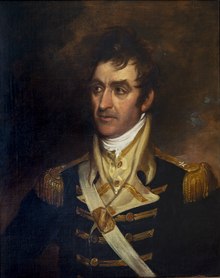William Wadsworth (officer)
Waving his sword and swearing at the troops back across the river, hoping to instill the fighting spirit in them, he made a genuine but vain attempt to get the militia to cross and reinforce their position.
Settling in "Big Tree" on June 9, 1790, on the east bank of the Genesee River, William and his brother went from the leading pioneers of this unsettled region to one of its largest wealthiest land holders.
Despite the fact William and his brother were now by any standard wealthy,[citation needed] they were living in their first log cabin when, in the summer of 1795, the Duke François Alexandre Frédéric, duc de la Rochefoucauld-Liancourt arrived from Canawaugus, New York, with his entourage of a young Englishman, servants and a poodle named Cartouche.
The duke, who had letters of introduction to "those great American Landlords, Messrs. James and William Wadsworth", was somewhat taken aback by their manorial dwelling.
Between August 20, 1797 and September 16, 1797, William Wadsworth hosted the United States delegation for the Treaty of Big Tree in his log cabin and new cobblestone house.
A meadow between the Wadsworths' cabin at Big Tree and the gigantic oak by the river, which gave the place its name, was the site of the conference.
That same day, William Wadsworth was promoted to brigadier general and put in command of the 7th Brigade, 1st Division made up of the 18th, 19th, and 20th regiments of the New York State Detached Militia.
They wrote to New York Congressman and Quartermaster General, Peter B. Porter, on April 15, 1812, about their concerns of the lack of arms and ammunition, adding "there is not five muskets that is fit to use in this place & they are not to be had in this quarter."
Governor Daniel D. Tompkins was made aware the New York Militia was destitute of arms, camp equipment, blankets, and other items.
On June 25, 1812, one week after his promotion and the declaration of war, Governor Tompkins ordered Brigadier General William Wadsworth and his newly formed 7th Brigade, with two cannons and ball, to command the Niagara Frontier and reinforce the 400 regular army at Black Rock.
This group brought General Wadsworth's combined strength to nearly 1,900 men at arms (including invalids and absentees) by July 10, 1812.
Under presidential pressure from Washington, D.C. Van Rensselaer began making plans to cross the Niagara River from his base at Lewiston, NY to capture the village of Queenston, Ontario and the nearby heights.
Captain John E. Wool, having landed, took command of the 13th United States Infantry Regiment, led a group of American soldiers up a fisherman's path to the British artillery stationed on top of the heights.
Ordering the heights to be fortified, he placed Lieutenant Colonel Winfield Scott in command with Brigadier General William Wadsworth leading the militia.
The latter [Wadsworth], who was in plain clothes at the time, modestly made his rank known, insisted on supporting Scott, which he did, with zeal and valor, in every combat."
Brock, an obvious target with his commanding height and general's uniform, was wounded in the hand and then shot and killed by American sharpshooters.
Meanwhile, General Wadsworth with a detachment of militia volunteers and Winfield Scott's regulars crossed the river to reinforce Captain Wool's position and take command.
Ultimately unsuccessful, Van Rensselaer dispatched a note to Scott and Wadsworth giving them permission "to withdraw if the situation warranted."
Abandoned by the militia, hearing the Mohawk war cries under John Brant and fearing massacre, Wadsworth's men retreated.
With no escape and the Mohawks, embittered over the loss of two chiefs, in pursuit, Scott was forced to surrender the remnants of his command to British Major General Roger Sheaffe.
When they would not, he shook his bright sword and cursed them so terribly that one awed eyewitness wrote, 'His language was said to be the worst in the whole American Army'."
Surprisingly, among them was Brigadier General William Wadsworth, who had negotiated the release of Major James Mullany and Captain Peter Ogilvie.
General Sheaffe relates he allowed Wadsworth's release in the hope "his going with the militia will... only tend to ensure a strict execution of the agreement."
